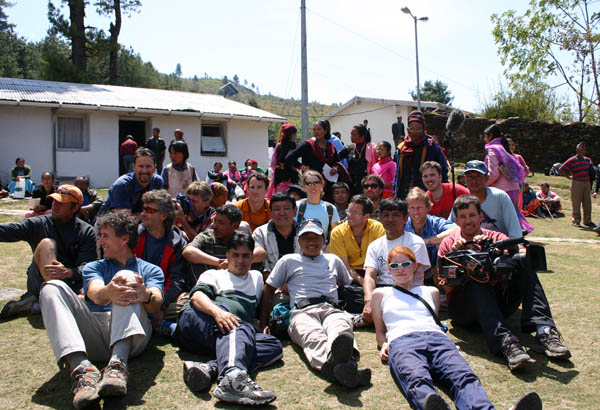|
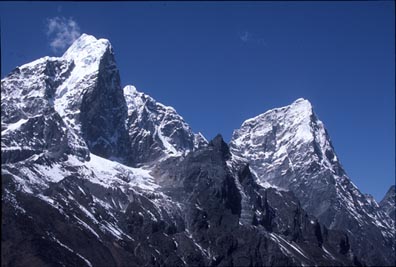 Go
Time!!
4/06/05 Go
Time!!
4/06/05
Itís not
often in the world of mountaineering that an expedition can say they are
going over to Nepal
not only to climb a beautiful 6000m mountain, but also help contribute to
eradicating curable and preventable blindness. Well, this is exactly what a
small crew of doctors, climbers, filmmakers, and photographers are about to
embark on for the next month and a half.
Welcome to the first web dispatch for the Himalayan Cataract Project
Expedition - Nepal, brought to you by The North Face, Voom High Definition,
Global Giving, The Himalayan Cataract Project, Serac Adventure Films, and
Outside Magazine
This multifaceted expedition will first travel into the Himalayas along with
Dr. Ruit and staff of doctors and aids from the Tilganga Eye Centre in
Kathmandu to help conduct several remote Eye Camps. Afterwards, the
expedition will continue into Nepalís Solo Khumbu region and attempt to
climb Cholatse, 6440m.
Leading this expedition is seven time Everest summiter, and North Face
Athlete, Peter Athans. He will be accompanied by long-time climbing friend,
and ophthalmologist, Dr. Geoffrey Tabin, who has also summited Everest. The
rest of the team will consist of North Face athletes, Conrad Anker, Kevin
Thaw, and Abby Watkins. A film crew from Serac Adventure Films consisting of
three time Emmy Award winner, Michael Brown, David DAngelo, and John Griber,
also a North Face athlete, will be filming a High Definition Documentary of
the expedition for Voom Networks Rush HD channel.
To tell the story of the expedition in print, Outside Magazineís Senior
Editor Nick Heil and photographer Ace Kvale will be there as well. Rounding
off the team are two additional photographers, Jordan Campbell and
Kristoffer Erikson.
A lot of you may ask, what is going on here? Eye Camps? Mountains?
Cataracts? High Definition? Tilganga? Magazines? Photographers? Global
Giving? Thereís a lot to this expedition, not only in its different
objectives, but also in the different people; the team, the doctors, and the
Nepalis.
Just about everyone on this expedition has been to Nepal previously, if not
multiple times. We come from many different backgrounds, but the one uniting
factor for all of us is that we are going back to Nepal this spring to give
something back.
For Dr. Tabin and the Serac Adventure Films crew, the journey starts today.
On Sunday, the remainder of the team will meet up with us in Nepal.
So stay tuned for the next couple of weeks, get to know about the team, the
doctors, the people of Nepal, climbing in the high Himalayas, and what itís like for someone to lift a
bandage and in some cases, see for the first time in years.
This is David DAngelo for Serac Adventure Films, catch yall in Nepal!!
The team has arrived (mostly)....
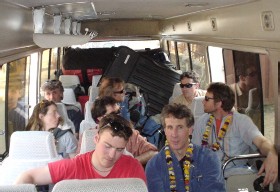
The jet lagged, yet chipper team waiting for
the road to open back up
Aside from
Abby and Conradís bags, and Jordan and Ace, the team is well, just about all
here. Some crazy weather in Denver is to blame for our two team-mates
delays.
For some, the craziness of Kathmandu
is nothing new - this is the third, fourth, fifth, ninth trip or so to
Nepal. For Abby and Nick, however, this is their first. And what a better
greeting than to get stuck in a traffic jam due to the King being
transported and the roads to the hotel being blocked off for 20/25 minutes.
Our president has been known to do the same from time to time so we canít
complain too much.
For a bus load of severely jet lagged folks, the crew took the minor delay
well.
After arriving at the hotel, the crew cleaned up, had a quick briefing about
the days ahead and grabbed a nice Thai dinner, before crashing relatively
early.
Tomorrow a visit to Tilganga Eye Centre will be in order for the team to get
acquainted with Eye surgeries, some will get a shave, and Pete Athans will
lead a crew into Kathmandu for some supply shopping.
Were all a bit tired, so thatís all for now. From here on out, well be
dispatching every day.
David
DAngelo
Holla' at them kebabs (and a Happy Nepali New Year
to you!
14 Apr, 04 - 13:58
Tomorrow morning when we wake up, it will be the year 2062. But for tonight,
people are out, restaurants are cooking kebabs outsider on the sidewalks,
and live music roars through the city...right into our open hotel windows.
An all woman Nepali rock band is jamming Billy Joel's "I may be crazy" as I
write this. It must have been a hit because they performed it two times in a
row! For us, itís New Years Eve all over again.
2062? Well, they do it a bit differently over here in terms of the
numbering. Wish I could tell you the reason why. Our Nepali trekking agent
Jiban told us a story this morning of trying to get into a night club in the
USA, using his Nepali ID. The doorman had a hard time believing him as his
Nepali date of birth was in the future, 2020 or something like that.
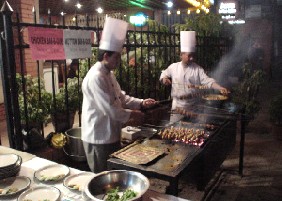 Some
bags did arrive today, but we're still missing two out of our three
photographers - Ace and Jordan are somewhere en route right now. Hopefully
we'll see them tomorrow afternoon. Some
bags did arrive today, but we're still missing two out of our three
photographers - Ace and Jordan are somewhere en route right now. Hopefully
we'll see them tomorrow afternoon.
Over the next couple of weeks we'll be writing more about the unique nature
of our expedition and introducing you to the team members.
Tonight we have North Face athlete Abby Watkins. She hails from Australia
and currently lives in Canada.
Abby's an amazing technical climber - ice or rock, awesome mountaineer,
elite guide, and is also the only woman on the expedition. Someone has to
keep the guys in check :)
Thoughtful and introspective, there's no one better to share the story of
the teams' past two days than Abby Watkins:
"From the parched, pre-monsoonal plains of India, the peaks of the Himalaya
surge onto the horizon, instantly recognizable. Kangchenjunga, Makalu,
Everest then Cho Oyo and Shishapangma distinguish themselves from the tumble
of snowy peaks. A thrill of anticipation hits my bloodstream; I'm actually
going to Nepal, a lifelong dream come true. The plane descends and we plunge
into the thick, brown smog which obscures the city of Kathmandu.
The mountains will have to wait.
Like many of the world's developing cities, Kathmandu rushes headlong into
the convenience of the internal combustion engine, forfeiting much of it's
beauty for the constant roar and honk of traffic and air pollution. Met by
our extremely courteous and kind Nepali hosts, we sit stunned and jetlagged
watching the kaleidoscope of life outside our van on the way to the hotel.
Cars, rickshaws and pedestrians share the road in a mind boggling dance
where the rules are invisible yet nobody seems to get hurt. Even the cows
wander through it all, sacred and seemingly oblivious to the mad crush of
human life around them.
Traffic comes to a complete halt. The King has decided to use the road today
for his personal convenience. The people will have to wait. Finally our
hotel, a shower and a bed.
Next day we travel to the hospital to meet Dr. Ruit and to learn more about
the cataract surgery and how we fit in with it all. Before I know it I am
scrubbed up and witnessing this miraculous procedure before my eyes as the
esteemed Dr. Ruit explains his every move. So meticulous are his movements
and precise his incisions. I watch in awe as he breaks up the old, cataract
affected lens of a patient and sucks it out with a tiny vacuum. Next, a
synthetic lens is carefully slipped into a lubricated space underneath the
cornea. Even more miraculously, seconds after this, the patient sits up and
is assisted off to the recovery room and will be able to see with their
'new' eye within a few days!
The team is then shown the on site facility where they make the synthetic
lenses. It is a high tech, sterile procedure involving eight steps and much
precision - a surprise amongst the teeming mass of subsistence based
humanity outside.
One more day in Kathmandu, where we will collect last minute supplies
and pack our expedition bags to head on ahead of us to Namche Bazaar. On
Friday we hope to slip through to Jiri on the road which is fraught with
strikes. Apparently it opened today but will close again on Saturday. It
will be good to get out into the countryside and see some of this unique and
incredible country."
A long and bumpy road
16 Apr, 04 - 16:25
10 hours and
10 sore necks later we are in Jiri! Kathmandu is awesome, but the crew is
definitely excited to get out of the smog and into the mountains - Jiri's
only at 5800 ft, but its good to go rural nonetheless.
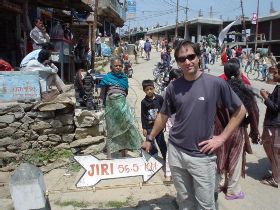 We
left the hotel this morning at 6 AM with all our bags and all our
team-mates. By some miracle, Jordan and Ace made it into Kathmandu last
night along with all their bags. No sooner than they arrived, they had to
wake up early this morning for the long bus ride to Jiri. Between the delays
in Denver and missing baggage in Hong Kong, our two team-mates were very excited to be
in country. Having less than 12 hours to transition to a long and gruelling
bus ride, that's another story. We
left the hotel this morning at 6 AM with all our bags and all our
team-mates. By some miracle, Jordan and Ace made it into Kathmandu last
night along with all their bags. No sooner than they arrived, they had to
wake up early this morning for the long bus ride to Jiri. Between the delays
in Denver and missing baggage in Hong Kong, our two team-mates were very excited to be
in country. Having less than 12 hours to transition to a long and gruelling
bus ride, that's another story.
The road to Jiri is long, narrow, twisty, and rarely flat. We also had to
make a pit stop in the afternoon at a nearby stream to refill the bus'
radiator. The driver just had to reach to his right, and lift up the hood,
which is located inside the bus to top off. Nothing like hot boxing a mini
bus with a blast of fresh diesel fumes inside the passenger compartment!
Tomorrow the team's first Eye Camp begins. In the morning, the Tilganga
staff also drove in from Kathmandu today and will start the screening process.
Folks from all over this area who have eye problems will be there. Some have
travelled for days to be here.
These screenings will assess exactly what their problems are and will
determine if cataract surgery can help. Then in the afternoon Dr. Tabin and
Dr. Ruit will start the surgeries. We're expecting over 100 patients and
maybe even 200 or more.
During the Eye Camp the North Face athletes will be helping transport and
prepare the patients for Cataract surgery. For some, this will be the first
time watching eye surgery. Needless to say, it might take time for some to
get used to watching an eye be cut into with a knife and a cataract plucked
out like a grape seed. Tomorrow a team member will tell you about their
experience in detail.
On a side north I had some questions for an eye doctor and at our final
diner in Kathmandu last night, was able to ask Dr. Tabin the
skinny on some old wives' tales I've heard over the years.
Number One: Reading
in the dark is bad for your eyes. FALSE - Dr. Tabin and his American
colleague, Dr. Chang, who was with us, said there was no proof that this was
true.
Number Two: Sitting too close to the TV is bad for your eyes. TRUE/FALSE -
While nothing has been proven that this will affect your eyes, Dr. Chang
suspected that this was based upon the TV's radiation. (Look at how close we
sit to computer monitors - even you! The person reading this dispatch right
now.) However, it has been proven that reading while holding a book too
close will negatively affect your eyesight.
There was another myth that was brought up last night involving teenager
boys and blindness. Verdict: No proven documented case.....yet
Dave
DíAngelo
Field Report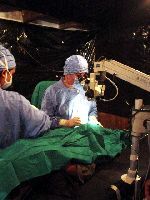 19 Apr, 04 - 03:56
Nepal, its people and the Himalaya draw us as travellers and adventurers
to its wonderful mix of culture and geography. The gateway to this small
landlocked nation is Kathmandu,
the political and cultural capital.
19 Apr, 04 - 03:56
Nepal, its people and the Himalaya draw us as travellers and adventurers
to its wonderful mix of culture and geography. The gateway to this small
landlocked nation is Kathmandu,
the political and cultural capital.
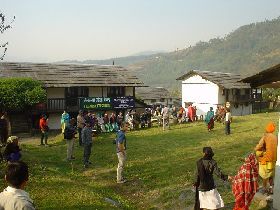 It
was seven weeks ago that I departed Nepal after the Khumbu Climbing School.
My Sherpa friends and I were climbing when on the first of February King
Gyanandra seized power by dismissing the parliament. The action was taken to
quell strife within the political system and address the Maoist insurgent
issue. It
was seven weeks ago that I departed Nepal after the Khumbu Climbing School.
My Sherpa friends and I were climbing when on the first of February King
Gyanandra seized power by dismissing the parliament. The action was taken to
quell strife within the political system and address the Maoist insurgent
issue.
A splinter group of insurgents have taken up arms to challenge the King.
Prior to our bus ride to Jiri a group of Russian tourists was ambushed en
route to Kodari, the border town with China. The assault was an isolated
incident, yet it gave pause to our own plans. Would our group be a target?
Should we consider an alternative mode of transport?
We
ended up hiring a bus to Jiri. It was no big deal. Our worries were for
naught. Nepali are good people.
Eye Camp
On the morning of the 16th of April the doors of the Jiri Technical College
were opened for the Tilganga Eye Camp. Over seven hundred Nepali filled a
green cricket pitch. In addition to screening for cataracts, the eye camp
provides eye assessment and prevention awareness. From the initial
registration onwards a feeling of community was present. Gossip and tea were
as much a part of the scene as the doctors and their instruments. Many
patients and their families had walked several days in hopes of treatment.
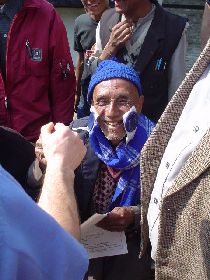 Cataracts
are small occlusions which form from the protein lens. Cataracts can be
removed and replaced with a synthetic lens, and is therefore a treatable
form of blindness. For the few patients suffering from cataracts this
weekend was an opportunity for renewed vision. Cataracts
are small occlusions which form from the protein lens. Cataracts can be
removed and replaced with a synthetic lens, and is therefore a treatable
form of blindness. For the few patients suffering from cataracts this
weekend was an opportunity for renewed vision.
The nursing students of the Jiri Technical College took vital signs and
prepared the patients for surgery. Once the eyelashes were trimmed and the
eye anesthetized the patients were ushered to one of two operating theatres
equipped with surgical microscopes. Dr. Sanduk Ruit of Nepal and Dr. Geoff
Tabin of the USA
performed 94 cataract surgeries in eight to ten minutes each. They have an
additional 40 patients this morning.
The patients are able to walk with assistance from the surgery theatre to a
dorm room where they are attended to by family. The following morning the
patients step out and have their bandages removed. The people beam with the
joy of sight.
The trusting and strong Nepali people inspire our team. From the patients to
the volunteers we are all taken by their earnest and caring approach. They
came to the eye camp with hope. Through the collective effort of the
Tilganga Eye Centre and two humble doctors many low income villagers have
had their sight returned. The Dolakha district got together for a health
check and a chance to visit.
We have one more day in Jiri to conclude this camp and will then trek to
Phaplu for the second clinic.
Thanks for following our expedition and your interest in the Himalayan
Cataract Project.
Sight is precious.
Our next update will be from our expedition leader Pete Athans in two days.
Check tomorrow for the picture of the day.
Conrad Anker
 Dil
Bahadur's story
20 Apr, 04 - 13:20 Dil
Bahadur's story
20 Apr, 04 - 13:20
Dil
BahadurTamang's cloudy eyes swept across the pastoral terraces above Jiri
vacantly, seeing nothing. On the back of his grandson he had been carried
for two days over tortuous, cruel terrain, his 84 year old body sensitive to
each individual step en route
More than two years ago his sight deteriorated to the point where he could
only perceive light intensity. His family, his subsistence farm and his
animals all lost intrinsic form. Despite the loss he took solace in the
voices of the familiar small family he found around him.
Yet he missed seeing the promise of each new day, heralded by the light of
morning dancing on the hills surrounding Tragdur village of Ramechap
District, his home for more than eight decades.
The excitement of life and youth's bold passions he hadn't the strength for
any longer; he cared not to revisit those tumultuous emotions. What he
missed, though, what he hungered for seemed so much more simple elemental
and pure. He realized it was the connection to this place that defined his
life; but he sensed it disappearing with his failing vision.
 In Jiri, he endured
the initial screening of patients at the camp, the incessant tests and the
trimming of his eyelashes. His grandson then carried him slowly to the doors
of the anaesthesia room where he was admitted immediately by hospital masked
attendants. In Jiri, he endured
the initial screening of patients at the camp, the incessant tests and the
trimming of his eyelashes. His grandson then carried him slowly to the doors
of the anaesthesia room where he was admitted immediately by hospital masked
attendants.
It was then he felt afraid. The smells were overwhelming, acrid and pungent
as he lay down helplessly on his back and prepared for what he knew not
it began with fluid in the eyes and a strange sense of weightlessness
engulfing and pulling him into a dreamy somnolence. But then the needle came
in below his left eye. His own cry surprised him because he had always
endured pain so well. Pain had begun to be not so unusual in his life
without vision. But this was excruciating, sharp and raw.
The needle seemed to drive upwards into his eye socket to a place behind his
eye, long and invasive. But then everything stopped and became dark and
warm. Then he must have slept, if only fitfully.
Dil awoke hearing the Doctor's voice that was insistent yet kind, calling
out to him in Nepali, eh grandfather; slide up on the operating table a
little. Then a bright light shone into his eye his neck became rigid and he
wondered how long this would take
...
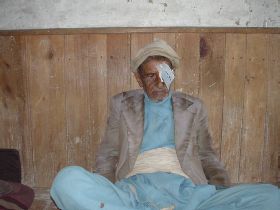 It
seemed an eternity. Little pinpricks into the eye followed, but there was no
more pain. Suddenly, as the green drape over his frail body was pulled back,
he realized it was over, that once again he had endured. He felt detached
but felt kindly, careful hands moving him outdoors gently into the warm
light. It
seemed an eternity. Little pinpricks into the eye followed, but there was no
more pain. Suddenly, as the green drape over his frail body was pulled back,
he realized it was over, that once again he had endured. He felt detached
but felt kindly, careful hands moving him outdoors gently into the warm
light.
Yes it was the same diffused light as always, but something seemed
different. He felt himself being carried up short steps into a darkened room
busy with voices, other patientís voices. It no longer mattered that he was
too tired to stay awake any longer.
Morning began normally enough with the call of roosters, the soft movements
of the other patients in the dimmed room, the familiar snoring of the person
next to him, his grandson. His eye felt a little swollen and the bandages
itched his temples that were wrinkled from eighty four years of worry.
He tugged on the bandages and one side fell away...at first there was
nothing but an unusual brightness without form, nothing recognizable But.
Then he turned his head towards the sounds of breathing nearby and he was
looking into the placid, sleepy face of his grandson.
In two years what a man he had become. The high forehead, wide bridge of the
nose yet gentle countenance all reminded him of his own face of sixty years
past .He felt a lightness of heart and gently shook the sleeping boy while
the diffused light of morning overtook the shade on the terraces above Jiri..
Pete Athans
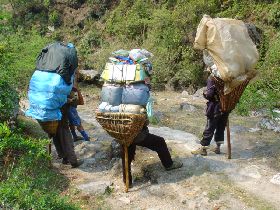 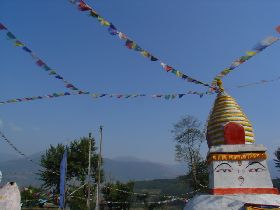 Jiri
to Phaplu
24 Apr, 04 - 04:14 Jiri
to Phaplu
24 Apr, 04 - 04:14
Ninety four people walked away from the make-shift Jiri clinic with
restored vision. Arriving to the project blind or with only slight light
sensitivity all then embarked their homeward journeys with vision
sufficient for a driver's license. Miraculous was the only way to describe
the scene & sentiment; bandage removal shone fresh colour and hope into
many lives. One older Gentleman declared 'God has arrived'. Clichť I know
but seeing the post -opp patients granted me a refreshed sense of humanity
& humility: My slight role rendered such positive feeling.
Jiri was the first of two scheduled Cataract Projects; Phaplu, the next
lay three days away. Our chance to utilize the Nepali highways, trails.
Beyond Jiri everything is moved on foot, porters assume the role of truck
drivers. Unfathomable loads issue from their conical baskets slung by a
single strap over the head: Sometimes shoulder straps but only to control,
mass is focused solely on the headband.
Everything from Chocolate to firewood makes up the one hundred and twenty
kilograms, two hundred pound loads!
Jiri used to be a fixture on the trek into the Khumbu but has become
neglected since air travel granted easier access to Mt Everest's valley.
Another factor is the insurgent activity, Kinja and the eleven thousand
foot pass of Lamjura La are reputed to be their stronghold and lay on our
route. Helicopters graze the cloud's ceiling taking supplies over the
conflict zone direct into the militarily secured Khumbu. Trekking
tourism is a considerable percentage of Nepal's Gross National Product
hence the large presence in Airport towns and specially the Khumbu. With
that said we did not meet a single Maoist representative while cruising up
and down the massive relief of the Himalayan foothills en route to the
second clinic site in Phaplu.
First trekking day took our excited throng over a nine then ten thousand
foot pass with the night spent in Bandahar. Day two was through Insurgent
controlled terrain yet no representative stepped forward requesting a
'donation' for their cause. Kinja's buildings displayed political
graffiti, leaving no doubt as to allegiance. Three thousand feet above we
finished the day in Sete, halfway up the Lamjura La pass.
Day three, up and over the pass descending through a blooming Rhododendron
forest into the town of Junbesi.
In Sete we meet a blind lady travelling to the eye clinic in hope of
vision. Buddha Maya had travelled from her village carried by two nephews,
our Expedition took their accommodation and food upon us and we travelled
the two final days together. Tempted to try and help carry but feeling the
locals more qualified in headband portaging: Fear of dropping her due to a
minor stumble is really what kept us from trying.
Phaplu is the current locale, yesterday was spent screening patients after
setting up the clinic in the town hospital. Today is the first day of the
eye camp.
Kevin
Thaw
Ace
Kvale
April 24th
After three and a half days of hiking my legs are still a little tired but
looking North in the morning we can see 23 000ft Himalayan peaks sparkling
in the sun. A reminder of the beautiful land we are visiting. Nepali
people are so warm and friendly. Every trip over here changes me in subtle
ways. To try to be more giving, more humble in our daily lives, to give
back just a bit more. As much as we can help with the eye camps we are the
ones that benefit. Truly the journey is the destination.
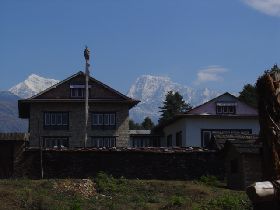 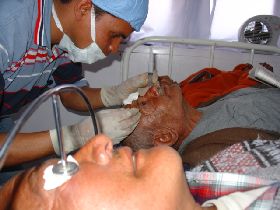 Phaplu
Clinic
25 Apr, 04 - 06:51 Phaplu
Clinic
25 Apr, 04 - 06:51
Yesterday we
started the second day of the Phaplu eye camp and over the course of the
last week I have gained a new appreciation for the sensory function of
sight. This morning as patients are being screened in the courtyard of the
Phaplu medical clinic I stare to the north at the beautiful Himalayan giants
and wonder how life would be living in such a magical place yet not seeing
the beauty that is all around.
With all eye camps there are volunteers that help make everything possible
and at this eye clinic my position has been to help with the anaesthesia of
the patients. I speak softly to each patient as I help them into the cold
white room that will be their first step on the journey back to sight. The
smell of betadine and disinfectant permeates the air giving the room a very
sterile feeling, a strong contrast from the mostly subsistence living
conditions from which most patients exist throughout the Himalayan
foothills.
 Bosnos,
Bosnos{sit, sit} Each person is guided to a bench and I begin by removing
their shoes. The patients rough and weathered feet are a stark contrast to
the white tile which their feet rest. As I tie plastic bags on each foot and
am given a glimpse into each persons life. I find the toe nails say most of
what can be told. Some of the nails where long and packed with dirt, these
people all wore shoes of some sort. Others have nails worn flush with the
toe leaving no room for dirt to penetrate, these people had no shoes or only
wore flip- flops. Most have walked for at least one day in hopes of having
their sight returned and now they wait frightened of the unknown. Bosnos,
Bosnos{sit, sit} Each person is guided to a bench and I begin by removing
their shoes. The patients rough and weathered feet are a stark contrast to
the white tile which their feet rest. As I tie plastic bags on each foot and
am given a glimpse into each persons life. I find the toe nails say most of
what can be told. Some of the nails where long and packed with dirt, these
people all wore shoes of some sort. Others have nails worn flush with the
toe leaving no room for dirt to penetrate, these people had no shoes or only
wore flip- flops. Most have walked for at least one day in hopes of having
their sight returned and now they wait frightened of the unknown.
I gently help each patient up onto two tables placed side by side so that
four people can lie down together. The anaesthesia is applied first through
drops to the eye in order to allow for a secondary, painless injection that
is made into the eye socket. There are patients that are scared and tremble
and I sense their tension, I try to provide some form of comfort despite my
only knowing a few words of Nepali. It seems to help and with some and I can
tell they understand despite our language barrier.
Their next stop is the surgical theatre where either Dr. Ruit or Dr. Tabin
will perform the cataract surgery. The following day their vision will have
returned and aside from eye drops placed in the eyes every two hours no
additional treatments are needed. A truly amazing process provided to the
patients at a fraction of the cost it would be in the western world and
through manufacturing technology developed exclusively in Nepal with Dr.
Ruit.
We will have two more days of eye surgeries in Phaplu before moving in to
the mountains.
Kristoffer Erickson
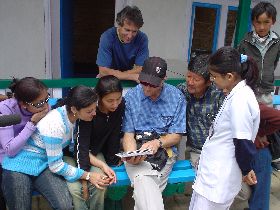 Phaplu
to Khumbu
26 Apr, 04 - 15:29 Phaplu
to Khumbu
26 Apr, 04 - 15:29
April 26th
-Jordan's
dispatch from Phaplu, Nepal
Today marks the last day of our second cataract eye camp. Set here in Phaplu,
this eye camp is seated underneath the imposing south faces of Numbur,
Khatang and Karyolung peaks which punch the sky at nearly 23,000 feet. There
is a great sense of accomplishment and euphoria among this Sight to Summit
team as we all feel strongly that our greatest objective of the expedition -
curing blindness - has been met with tremendous success.
As it stands, we've assisted Dr. Tabin and Dr. Ruit with over 250 cataract
surgeries between the two eye camps. It is difficult to put into words how
it feels to take part in restoring eyesight and in so many ways giving
people back their lives!
Last night after dinner, a shared camaraderie and profound sense of
cross-cultural stewardship resonated in our hearts as we raised a glass with
the doctors of Phaplu and the medical staff from the Tilganga Eye Centre.
Here in Phaplu, we have made new friends and shared something unique and
special.
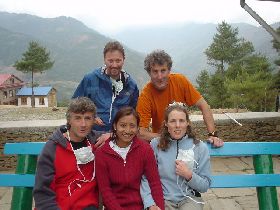 This expedition
to cure preventable blindness in high Asia is the realization of a personal
five-year long dream and yet I've found the work can be tiring and
emotionally draining at times. Through my own experience I've seen the other
team members working hard as well. Without exception, I've been impressed by
each and everyone from The North Face, Outside and Serac Adventure Films. This expedition
to cure preventable blindness in high Asia is the realization of a personal
five-year long dream and yet I've found the work can be tiring and
emotionally draining at times. Through my own experience I've seen the other
team members working hard as well. Without exception, I've been impressed by
each and everyone from The North Face, Outside and Serac Adventure Films.
Over the course of this trip, I've watched Abby Watkins and Kevin Thaw work
tirelessly to assist and comfort so many patients before and after surgery.
I've watched Conrad Anker dig deep to assist and observe both Dr. Tabin and
Dr. Ruit with patients during the actual surgeries - a rather queasy task if
you're unacquainted with the medical world. Kristoffer Erickson has also
rolled up his sleeves and jumped in big time with any down time when he's
not shooting for North Face.
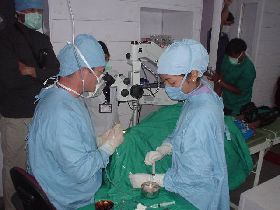 Nick Heil and
Ace Kvale from Outside have taken great time and care to document this
incredible, miraculous sight-restoring experience through extensive
interviews and thousands of photographs. I expect we'll see a very special
story in the months ahead. Nick Heil and
Ace Kvale from Outside have taken great time and care to document this
incredible, miraculous sight-restoring experience through extensive
interviews and thousands of photographs. I expect we'll see a very special
story in the months ahead.
Arguably the most challenging aspect of the Sight to Summit project is
trying to secure a meaningful film. Michael Brown and the Serac crew; John
Griber and Dave D'Angelo, have been such pros, keeping a stiff upper lip
during long shoots, after hour edits and slogging around heavy camera
equipment. I am well-impressed and humbled by their hard work.
So why the big pats on everyone's backs you ask? Considering how many
expeditions fail just through bad planning, group-dynamics and basic trip
jerks, I feel extremely lucky to be with so many easy-going and experienced
people, all of whom have hearts of gold and who have chosen to be here to
make some contribution to the HCP cause.
Last night I sat with our legendary expedition leader and soft spoken
gentleman, Pete Athans. With a whiskey in-hand we sat around a pot bellied
stove at Dr. Mingma's Sherpa Hotel and discussed the team's success on the
first leg of this transformational journey. Pete seemed very pleased and
this in turn secretly made me glow inside.
Tomorrow the helicopter comes early and we plan to lift off for the Khumbu.
Most of the team has been there before but a few of us have not. This will
be my first time to this part of the Himalaya,
realizing another lifetime dream.
While the past few weeks have been stellar, we have an enormous task to
climb Cholatse in what will amount to a slender ten days on the mountain.
I'm already feeling the big mountain angst, from climbing style decisions to
a fairly challenging acclimatization schedule.
In the end, what matters most is that we ascend Cholatse in the same great
style we have worked together here in Phaplu and Jiri as a team. I have high
expectations.
Jordan - Ramro J
 Dawaís very
first dispatch.
30 Apr, 04 - 14:16 Dawaís very
first dispatch.
30 Apr, 04 - 14:16
Sorry we
haven' rapped at you in a couple of days. To make up for it we've got a
special treat for y'all.
A big part of this trip is our staff over here in Nepal. We have all sorts
of support. Our Sirdar, our porters, climbing sherpas, cooks, and even the
yaks that bear the brunt of our heavy loads to base camp.
Tonight we've got none other than Dawa Sherpa coming at you from Pangka,
about 14,500 ft. We're just a day away from our Base Camp for Cholatse.
This is Dawa's first dispatch and it will not be the last. Next month, after
he is done with our expedition, he's going to venture off on an amazing
bicycle journey and will be equipped with the same Contact 3.0 dispatching
system that we're using on this trip. He'll tell you more about his upcoming
trip later on in this dispatch.
Dawa Sherpa has worked many times with our expedition leader, Pete Athans,
including an Everest summit with him in 2002. He also works very closely
with Conrad Anker and the Khumbu climbing school, which has been teaching
the people of the Khumbu region proper climbing and safety techniques.
On this expedition he is working with Serac Adventure Films and will be
instrumental in the forthcoming climb ahead of us. During the eye camps he
was a part of the film crew and amongst helping with the filming he was also
an amazing translator. He can speak 7 different languages!
Dave DíAngelo
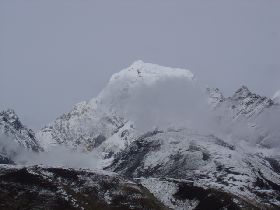 Without further
adieu, Dawa Sherpa: Without further
adieu, Dawa Sherpa:
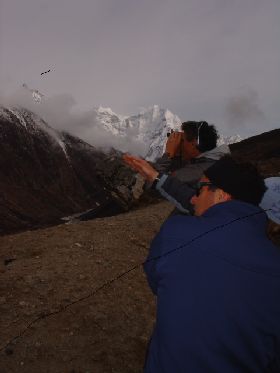 The eye camp was one of the most wonderful
experiences of my life. I never have seen anything like it and was truly
surprised by all the wonderful feelings and experiences. How someone comes
in with the help of their family member or friends and after the cataract
surgery next day they move around with a lot more confidence. The eye camp was one of the most wonderful
experiences of my life. I never have seen anything like it and was truly
surprised by all the wonderful feelings and experiences. How someone comes
in with the help of their family member or friends and after the cataract
surgery next day they move around with a lot more confidence.
Thanks to TNF for such a nice program and thanks to Dr. Ruit and Dr. Geoff,
special thanks goes to the team everyone worked so hard to make the eye camp
a success. Itís just like having a picnic everyday, everyone has something
to tell, something to learn and something to appreciate!
Personally itís just a learning process, I believe I will be just learning
for the rest of my life and I like it. Today we're here at Panga its at the
Gokyo valley, the altitude is about 15000ft. Conrad, Chris, and Karsang left
Phorche early this morning to find the best possible spot for the Cholhotse
BC and they will meet the advance yak team, the yak team have all the
necessary gear for the BC including food. Dr. Jeffís daughter Allie also
left Phorche with Mingma Tshere to get to Lukla on the way back to home USA!
Tomorrow all of us will be at the BC, next day 1st of May, 2005. We will
have our puja ceremony on the 3rd and will start work towards the summit of
Mt. Cohlhotse! May Buddha bless us with the good weather and Karma!
I'm sure everything will be very good and nice under the leadership of Peter
sahib, every single team member is a funny person. I'm firmly sure that I'm
such a lucky person to get such a great opportunity to work with such
wonderful people!
After this Mt.
Cholhotse expedition I might have to spend about a month or so on my proper
documents to my Gelu Expedition CP with the Nepal
government. Just have a dream for 14 years to do all the above 5000mts
passes by the mountain bike. Finally I'm here at the no turning back point
towards my dream. I know its very daunting task but I have to do what I have
to do.
I appreciate the biggest support from TNF to my Gelu Expedition CP. I
appreciate the greatest help from Jennifer-Conrad Anker, Peter sahib, Carl
Strong of Bozeman
and itís quite a long list of friends of friends I want to appreciate!
Without my wife Bindu and family support I wouldnít be able to do this or
any expedition!
Dawa Sherpa.
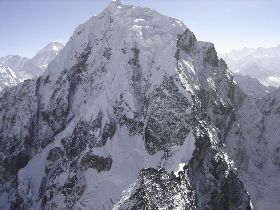 Basecamp!
2 May, 04 - 14:38 Basecamp!
2 May, 04 - 14:38
Basecamp at
last! Ascending to altitude demands a slow pace, for which walking is the
perfect mode of transport. We've spent the past four days making our way to
Cholatse Basecamp and have already made progress up onto the glacier. Conrad
and Chris arrived a day earlier than the rest of us and proceeded to fix
five pitches of scruffy mixed climbing over recently exposed rock. Climbing
this type of feature becomes more and more common in today's warming
mountain climates: where there used to be ice, now lie loose, down-sloping
slabs.
The mountain looks far drier in general than photographs only as old as ten
years show. The climbing will be very different from accounts of previous
ascents. Tomorrow we hope to make it up to the col on the SW Ridge and put
up a tent or two. From there we will get a good look at the ridge proper to
see how much of it is now rock climbing [and how to best get onto the upper
glacier].
Meanwhile, in basecamp, we have just been graced by a Puja ceremony given by
a local Monk. He hiked over the hill from where he was grazing his family's
yaks and appeared in basecamp in his ragged but well-kept robes. The Sherpas
on our staff set up a beautiful Chorten [rock cairn with spiritual
significance] and makeshift altar piled high with food and beer.
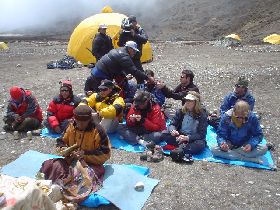 The Lama began
chanting as a juniper branch fire was lit and continued to smoke throughout
the ceremony. We were given beer and told to drink up, for the ceremony's
potency relies on creating happiness. Ritually, the Sherpas raised a tall
pole of prayer flags and stretched out long strings of prayer flags to
either side of the chorten, creating a solemn, happy and moving spectacle
presiding over our tents. The Lama began
chanting as a juniper branch fire was lit and continued to smoke throughout
the ceremony. We were given beer and told to drink up, for the ceremony's
potency relies on creating happiness. Ritually, the Sherpas raised a tall
pole of prayer flags and stretched out long strings of prayer flags to
either side of the chorten, creating a solemn, happy and moving spectacle
presiding over our tents.
The lama chanted more, then a ritual offering of food was placed on the
Chorten and we all partook in the ritual food. A pair of Choughs (high
altitude birds in the crow family) decided to eat the sacred food as well by
systematically stealing it from the chorten. The scraps were cleaned up by
the scruffy camp puppy. So, in the accepting, real yet spiritual way of this
country, we blessed the mountain and our climb, ate drank and made merry and
fed the little beings who are also affected by our presence.
As our bodies adjust to the rarefied air we will continue to inch our way
towards the summit, taking loads up the moraine, leading into unknown
terrain, leaving a trail of rope or footsteps behind us and coalescing into
a team.
Abby Watkins May 5th.
What Awaits Ahead
8 May, 05 - 10:06
Peter Athans
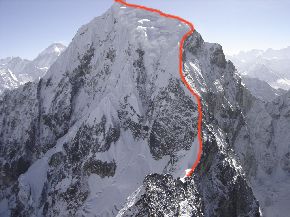
The trail from base camp wanders lazily upwards through an expansive valley.
Our route is bordered by ridges that will shortly sound with the peaceful
echoes of yak bells. Winter has now given way to a tentative spring and
moisture from the south invades daily, obscuring our views in a tantalizing
and frustrating way.
Despite the clouds, we know what exists at the valley's terminus: 6000 feet
of rock, snow, ice and altitude, our peak of Cholatse. While beautiful and
alluring this mountain's sinuous ridges and enormous West face are
unquestionably daunting. The mountain's defences are formidable and
frequently hidden but fortunately our approach is pleasant distraction. The
faint path skirts three turquoise high altitude lakes and could hardly be
more pleasant .This is how the mountain is beguiling because now, abruptly,
everything changes.
From the lakes our mountain boots replace hiking shoes and we ascend several
hundred feet of loose scree and talus to a 200 hundred meter gash of rock
and ice that leads to a hanging glacier and onward to the South West ridge.
While difficult technically, this feature allows us to bypass the dangerous
ice towers and massive hanging seracs that threaten to topple down the west
face. Our route is safe but this doesnít make the ascent physically easier.
6 rope lengths of steep climbing gradually give way to snowy couloirs that
wind up into the heart of Cholatse's obstacles. Yet confronting these
difficulties is why we have come,
to embrace them, solve them and continue our exploration up the mountain's
graceful features and into our own hearts.
The eye camps are now behind us yet I find myself frequently returning to
those miraculous days in Paphlu and Jiri. Dr Tabin and Dr. Ruitt performed
tirelessly in those days restoring the sight to above two hundred deserving
patients who had travelled from afar. Our team worked assiduously along side
them, selflessly giving our time and sacrificing our own desires for the
opportunity to serve others. Now is our time to climb and the expedition has
shifted gears considerably. But the surprise of the patients in having their
vision restored their startled and then beatific faces will remain with us
throughout the difficult days ahead. To find ourselves we have first had to
lose ourselves in objectives for the welfare of others; now, we find
ourselves at the foot of this sublime mountain and contemplate the climb's
meaning. While the answer is different for each of us we will all find it
irrevocably linked to the wonderment and joy in the eyes of Chandra Maya at
having her sight restored after many years of stultifying blindness..
Our first camp is in the seracs at 17500 feet and is only a pause before the
800 feet of ice barring the way to the South West ridge. Conrad, Michael,
Kevin and John are at the break in the bottom of the ridge on the pass or
col at 18200 feet; Abby, Geoff, Nick and Jordan wait in the tents below and
will move tomorrow. Chris and I will join the group at the col from base
camp. Then, we will plan for the challenges of the 3000 feet of technically
difficult terrain above. Only the imagination can fathom what is ahead but
suffice it now to dream until we greet the morrow.
Jordan Campbell's Dispatch
12 May, 05 - 12:29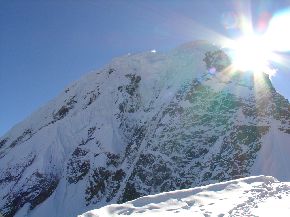
Cholatse
Base Camp
May 12, 2005
Welcome Friends!
In only six days after arriving in Base Camp, our Sight to Summit team
was able to secure a spectacular Camp
II location on Cholatse's southwest ridge at 18,200 feet. This tremendous
effort pushing a safe route up the mountain is credited to Conrad Anker and
Kristoffer Erickson - clearly our strongest and most eager climbers!
On May 7th, I arrived at Camp II's lofty and remarkably spacious camp site.
Much like the transformational experiences of the eye camps two weeks ago,
the view of so many Khumbu and Rowaling peaks made me question what is
important in life.
The next morning Kevin Thaw and I set out to fix lines on the rock pyramid
just outside of camp - the last big technical hurdle before summit attempts
could get under way.
I led a healthy stretch of water ice, fixing the belay with a well-placed
piton - hammered in the rock headwall. Thaw led two more traversing rock
pitches with ''mind riot'' exposure [as Conrad likes to put it] and we
topped out in the afternoon clouds, satisfied with our job.
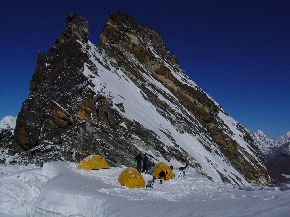 On May 9th, Pete
Athans, Geoff Tabin, Conrad Anker, Kristoffer Erickson and Michael Brown
made an impressive 21 hour round-trip push up the southwest ridge reaching
over 20,000 feet. On May 9th, Pete
Athans, Geoff Tabin, Conrad Anker, Kristoffer Erickson and Michael Brown
made an impressive 21 hour round-trip push up the southwest ridge reaching
over 20,000 feet.
From our spectacular vantage point at 18,200 feet, the rest of us watched
the first climbing team all day inch their way up towards Cholatse's fairy
tale summit.
Via a small, hand-held radio, I spoke with Pete Athans at 2:00 PM. Pete's
dispatch to all of us indicated it was time to turn around rather than go
for the top and risk an open bivy high on the mountain.
While Athans and team had pioneered the southwest ridge route, the summit
still loomed a bit too far. The five climbers arrived back at the Col Camp
at 10:00 pm - rappelling the rock pyramid by headlamps.
Back at Base Camp we awoke this morning to see Conrad and Kris making a
second attempt on Cholatse along with Kevin Thaw, John Griber and Abby
Watkins.
JUST IN:
The official word from Conrad's last radio call at 2:00 PM is total success! All of the second climbing teams reached the
summit this afternoon and are en route back to Camp II.
Everyone here in base is thrilled and we'll get ready to celebrate tomorrow
night! For now, well keep the juniper burning for our compadres still on the
mountain.
Count on some great upcoming dispatches from our summit climbers in the days
ahead!
Jordan [Ramro J]
Kevin Thaw
05-16
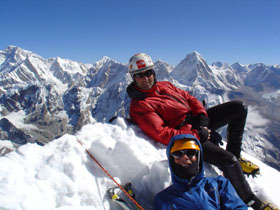 The
morning of May 12th was crisp & perfectly clear, scant condensation lurked
only in the lowest valleys. All of Khumbu's summits stood calm & clear in
that early light: Cho Oyu, Pumori, Everest, Nuptse,
Lhotse, Makalu, Ama Dablam,... Conrad Anker, Kris Erickson, myself - Kevin
Thaw, Abby Watkins and John Griber stood atop 6440m Cholatse soaking in the
awesome, spiky Himalaya skyline. The
morning of May 12th was crisp & perfectly clear, scant condensation lurked
only in the lowest valleys. All of Khumbu's summits stood calm & clear in
that early light: Cho Oyu, Pumori, Everest, Nuptse,
Lhotse, Makalu, Ama Dablam,... Conrad Anker, Kris Erickson, myself - Kevin
Thaw, Abby Watkins and John Griber stood atop 6440m Cholatse soaking in the
awesome, spiky Himalaya skyline.
Cholatse's southeast ridge
had relented very quickly, much faster than anticipated. Opting to climb at
night for crisp, secure ice conditions we arrived onto the summit plateau
just as the first light ignited surrounding peaks silhouettes. We'd left
18000ft Col camp shortly after sunset the prior evening, simul-climbing
was our employed mode: Moving together with the rope and protection between
us, much faster than belaying each rope length in the traditional style. We
stopped en route four times to exchange equipment and leader. A brief rocky
introduction then solid, not too steep ice for the journey's mainstay. Sixty
five-ish degrees with a few steeper pitches to be deposited onto a football
field plateau and a final summit ridge.
While basking and taking a
short break at the base of the final snow ridge traverses to the summit,
myself, Abby & John were joined by Conrad and Kris whom had begun the route
at one pm and sped through the night. We continued all together traversing
snow ridges above the west face, a steep 10m headwall was all the
fortification the true summit offered: A thin snow fin, large and solid
enough for all five of us.
Descent went smoothly via
'V' thread rappel anchors placed a couple of days prior by Conrad & Kris
attempting the peak with Geoff, Pete & Michael. All of us were safely back
at the tents on the col for afternoon tea.
The following morning
required rapid exodus, from the col camp to base, packed and hike out the
following morning. We had climbed on the last possible day and are now back
in Kathmandu after a rapid exit; two long days en foot and a flight from
Lukla to the city.
We are awaiting a final
meeting with Dr Ruit, the Tilgunga eye centre staff and local dignitaries.
Filmmaking
May
18th, 2005
Michael
Brown
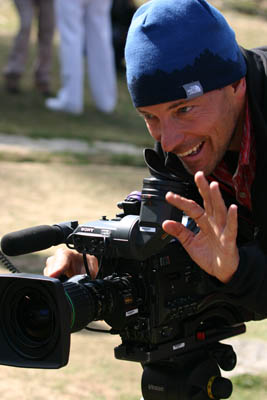
The cable High Definition network Rush HD sent Serac Adventure Films crew
David D'Angelo, John Griber and I along to tell this story in
spectacular HD (High Definition). This has been one of the special trips
that one dreams of being involved with, especially as a filmmaker.
Our film will be an interesting challenge in the editing. We have two very
different aspects of this story. One is the eye camps and the other the
climb. We are absolutely moved by the footage in the cataract camps and the
Nepali people regaining their eyesight. One woman referred to herself as a
"Sun Setting on the Mountains." She was so grateful for having their
eyesight back, even though she is quite old. Now these people have the
ability to contribute to their families once again. It is like a new life,
one can see as they regain their lost personalities and stand up straight
once again.
The climb was truly exciting and much more technical than I expected.
Indeed steeper than any I have done before. This was much more like ice
climbing and it went on and on.
Blending these two very different aspects in our film is our challenge and
it is an intriguing one.
I gained enormous respect for Conrad as he got excited about the filming and
made much of the mountain shooting possible. He makes a distinction between
expedition style, alpine style and now 'film style'. Kris and Conrad are
quite a strong team on the mountain and took me along in the early stages to
get images as they pioneered our route. It is a spectacular place for
shooting. On our first summit attempt they switched off on the lead as I
brought up the 25-lb camera. None of us expected just how long and sustained
the route would be. We fell short of the summit as time ran out and the snow
conditions bogged us down. Two days after our first failed attempt they were
recovered enough to go back and get the job done.
Back in Colorado
we will be working long hours with our Final Cut Pro
putting the footage together in a meaningful way. We have a plan and I will
be looking forward to your thoughts on the way we plan to edit this story.
|
![]() Compiled dispatches, originally sent live from
the field with a PDA / Sat phone combo
Compiled dispatches, originally sent live from
the field with a PDA / Sat phone combo